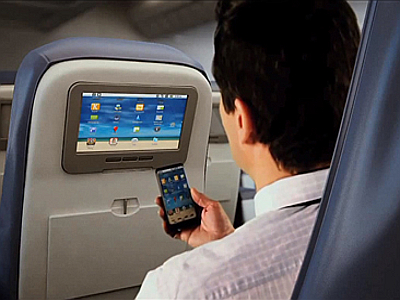Screenovate Miracast Plus Wirelessly Links Smartphone, HDTV
This new tech will be based on Miracast and allow device owners to beam content to a compatible device.
On Friday Verizon Wireless updated its blog about what it plans to show at CES 2013 in Las Vegas. One of these entries said that soon smartphones will be able to turn a user's TV into a Smart TV without the need for an overly expensive internet-based HDTV, set-top box or Blu-ray playeer. It will be accomplished through Screenovate's Miracast Plus which will presumably be offered in smartphones sold by Verizon in 2013.
"The Screenovate solution allows an HD movie to be beamed to a big screen TV from a smartphone, while allowing the phone to keep functioning as a smartphone, independently of the beamed content," the company said. "It also allows game players to access a customized gamepad controller that fits the game’s and the player’s needs when that game is beamed to the big screen. And with usability always in mind, the solution makes it simple to keep eyes on the big screen when browsing the Web, rather than moving them back and forth between the big screen and the smartphone itself."
Unfortunately, little else was revealed about the Miracast Plus stack. Miracast, a peer-to-peer wireless screencast standard, was created by the Wi-Fi Alliance. It's an open alternative to Apple's own AirPlay Mirroring, allowing users to project in real-time content on one device to the screen of another device. These connections are formed via Wi-Fi Direct which is supported by Google's Android 4.2 "Jelly Bean" OS.
So far supporting devices include the Nexus 4, Sony Xperia T and V, and a few others. Intel's WiDi 3.5 will be Miracast certified as well as tech provided by Broadcom, Marvell, MediaTek, Nvidia (Tegra), Qualcomm, Ralink, Realtek, and Texas Instruments. However to get a Miracast connection to work, both devices will need to be Miracast-capable, thus in 2013 we'll likely see Miracast-certified adapters that plug into USB and HDMI ports.
Last year, Screenovate introduced an optimized version of its Wireless Display Plus solution for TI's OMAP 4 line of SoCs. This allows Android smartphones and tablets sporting TI's chip to beam the device's UI onto other media platforms, such as TV, car display and PC monitor, over standard Wi-Fi connection. The tech was based on the then-emerging Miracast standard.
Contact Us for News Tips, Corrections and Feedback
Get Tom's Hardware's best news and in-depth reviews, straight to your inbox.

Kevin Parrish has over a decade of experience as a writer, editor, and product tester. His work focused on computer hardware, networking equipment, smartphones, tablets, gaming consoles, and other internet-connected devices. His work has appeared in Tom's Hardware, Tom's Guide, Maximum PC, Digital Trends, Android Authority, How-To Geek, Lifewire, and others.
-
chumly They are proposing wirelessly streaming HD video to a receiver via mobile when there isn't a good solution available on market right now. The last I read about WHDI for consumers was from a Galaxy GTX 460 quite awhile ago, and from the reviews I've read it didn't go over so well. Are they planning on broadcasting straight to the TV from the phone? Call me skeptical.Reply -
archange HD broadcasting from mobile to TV is long since here, thanks to DLNA. Skifta does that for free. And there are similar technologies integrated out-of-the-gate, I'm thinking Samsungs's allshare.Reply
Granted, this seems to bring the level of functionality further than just streaming media, which is good. But correct me if I'm wrong, this seems like yet another proprietary tech, when what we really need are good old open standards...
